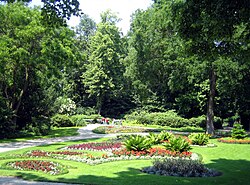
The following is a list of notable parks, gardens, and outdoor spaces in Berlin, Germany.

The following is a list of notable parks, gardens, and outdoor spaces in Berlin, Germany.

Peter Joseph Lenné was a Prussian gardener and landscape architect. As director general of the Royal Prussian palaces and parks in Potsdam and Berlin, his work shaped the development of 19th-century German garden design in the Neoclassical style. Laid out according to the principles of the English landscape garden, his parks are now World Heritage Sites.

Glienicke Palace is a historic palace located on the peninsula of Berlin-Wannsee in Germany. It was designed by Karl Friedrich Schinkel around 1825 for Prince Carl of Prussia. Since 1990, Glienicke Palace and the park have been part of the UNESCO World Heritage Site "Palaces and Parks of Potsdam and Berlin" because of their unique contribution to Prussian landscape architecture.

The Volkspark Mariendorf is a park located in the Mariendorf part of Berlin's borough Tempelhof-Schöneberg, and was built in 1924. It covers approximately 13 hectares. The landscape architect was Ernst A. Harrich.

Sanssouci is a historical building in Potsdam, near Berlin. Built by Prussian King Frederick the Great as his summer palace, it is often counted among the German rivals of Versailles. While Sanssouci is in the more intimate Rococo style and is far smaller than its French Baroque counterpart, it, too, is notable for the numerous temples and follies in the surrounding park. The palace was designed and built by Georg Wenzeslaus von Knobelsdorff between 1745 and 1747 to meet Frederick's need for a private residence where he could escape the pomp and ceremony of the royal court. The palace's name is a French phrase meaning "without worries" or "carefree", emphasising that the palace was meant as a place of relaxation rather than a seat of power.
Leberecht Migge was a German landscape architect, regional planner and polemical writer, best known for the incorporation of social gardening principles in the Siedlungswesen (settlement) movement during the Weimar Republic. Renewed interest in his work in recent decades bears relevance to current concerns about sustainability.

Palaces and Parks of Potsdam and Berlin are a group of palace complexes and extended landscaped gardens located in the Havelland region around Potsdam and the German capital of Berlin. The term was used upon the designation of the cultural ensemble as a World Heritage Site by UNESCO in 1990. It was recognized for the historic unity of its landscape—a unique example of landscape design against the background of monarchic ideas of the Prussian state and common efforts of emancipation.

The Britzer Garten is a large park in Berlin, named after Britz, a neighborhood of the borough of Neukölln. It was constructed for the Bundesgartenschau 1985, in order to provide a new landscape park to the citizens in the southeast of West-Berlin, who were at that time cut off from the surrounding countryside.

The Stadtpark und Botanischer Garten Gütersloh is a municipal park with botanical garden located at Parkstraße, Gütersloh, North Rhine-Westphalia, Germany. It is a member of the European Garden Heritage Network and open daily without charge.

The Biosphäre Potsdam is an indoor tropical botanical garden located in the Volkspark Potsdam, a park between the Sanssouci Park and the Neuer Garten Potsdam at Georg-Hermann-Allee 99, Potsdam, Brandenburg, Germany. It is open daily; an admission fee is charged.
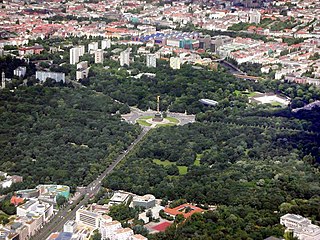
The Tiergarten, formal German name: Großer Tiergarten, is Berlin's most popular inner-city park, located completely in the district of the same name. The park is 210 hectares in size and is among the largest urban gardens of Germany. Only the Tempelhofer Park and Munich's Englischer Garten are larger.

Volkspark Friedrichshain is a large urban park on the border of the Berlin neighborhoods of Friedrichshain and Prenzlauer Berg. The oldest public park in Berlin, at 52 hectares, it is also the fourth-largest, after Tempelhofer Park, Tiergarten, and Jungfernheide.

Gärten der Welt is a public park in Marzahn, Berlin. It was opened on 9 May 1987 as Berliner Gartenschau and was renamed Erholungspark Marzahn in 1991, before adopting its current name in 2017. The total area encompasses more than 100 hectares.
The Prussian Palaces and Gardens Foundation Berlin-Brandenburg was founded by a treaty of 23 August 1994 between the German federal states of Berlin and Brandenburg as a public foundation following German reunification. The treaty came into force on 1 January 1995. The foundation is separate from the considerably larger Prussian Cultural Heritage Foundation.
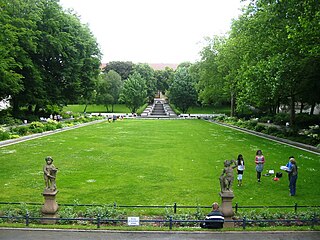
The Körnerpark is situated in Berlin Neukölln between Jonasstraße, Schierker Straße, Selkestraße and Wittmannsdorfer Straße. The approximately 2.4 hectare park resembles a palace garden. The feature in the eastern part of the park is a cascade with fountains. Opposite, to the west, an orangery houses a café and a gallery for temporary exhibitions, and forms the boundary of the park. During summer weekends the forecourt of the orangery is used for free concerts and performances. The northern part is dominated by a flower garden.

Altona Volkspark is a 205-hectare (507-acre) large urban park in the Hamburg district of Bahrenfeld, in the borough of Altona. Ahead of Hamburg Stadtpark, it is the largest park in Hamburg. Altona Volkspark is located some 3 km off the inner city. The largest parks in the city-center are Planten un Blomen and Alsterpark.

Goethepark is a public park in Wedding, a locality of Mitte, Berlin, Germany. The park was created and constructed from 1922–1924. The park covers approximately 37 hectares. Together with Volkspark Rehberge, which is located adjacent to the north-west edge of the park, the total park landscape is approximately 115 hectares. To the west is the Plötzensee and its surrounding park.

Park Glienicke, is an English landscape garden in the southwestern outskirts of Berlin, Germany. It is located in the locality of Wannsee in the Steglitz-Zehlendorf borough. Close to Glienicke Bridge the park is open to the general public. The park is part of the UNESCO World Heritage Site Palaces and Parks of Potsdam and Berlin. Within the ensemble it is one of the five main parks, the others being Sanssouci Park, New Garden, Babelsberg Park and Peacock Island (Pfaueninsel). Regarding diversity in gardening styles within the Potsdam park ensemble Park Glienicke is only superseded by Sanssouci Park. Furthermore, it is a park especially characterized by one personality due to the intense involvement of Prince Charles of Prussia. The park covers approximately 116 hectares
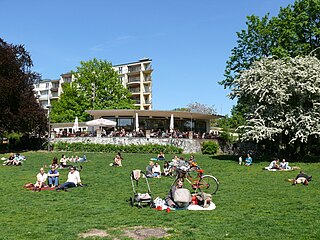
The Volkspark am Weinberg is the only Volkspark in Berlin's Mitte locality in the district of the same name and covers an area of 4.3 hectares. It is bordered by Weinbergsweg to the southeast, Brunnenstraße to the southwest, Veteranenstraße to the northwest and Fehrbelliner Straße to the northeast. The name Weinberg (vineyard) goes back to the vineyards that formerly occupied the hill on which the park is now situated. Since the late 1970s, the park has been designated as a garden monument (Gartendenkmal).
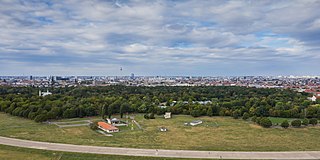
The Volkspark Hasenheide is a park of around fifty hectares in the Berlin district of Neukölln on the border with Kreuzberg. The name of the park goes back to the use of the area as a rabbit enclosure from 1678. The Great Elector, Frederick William hunted there.